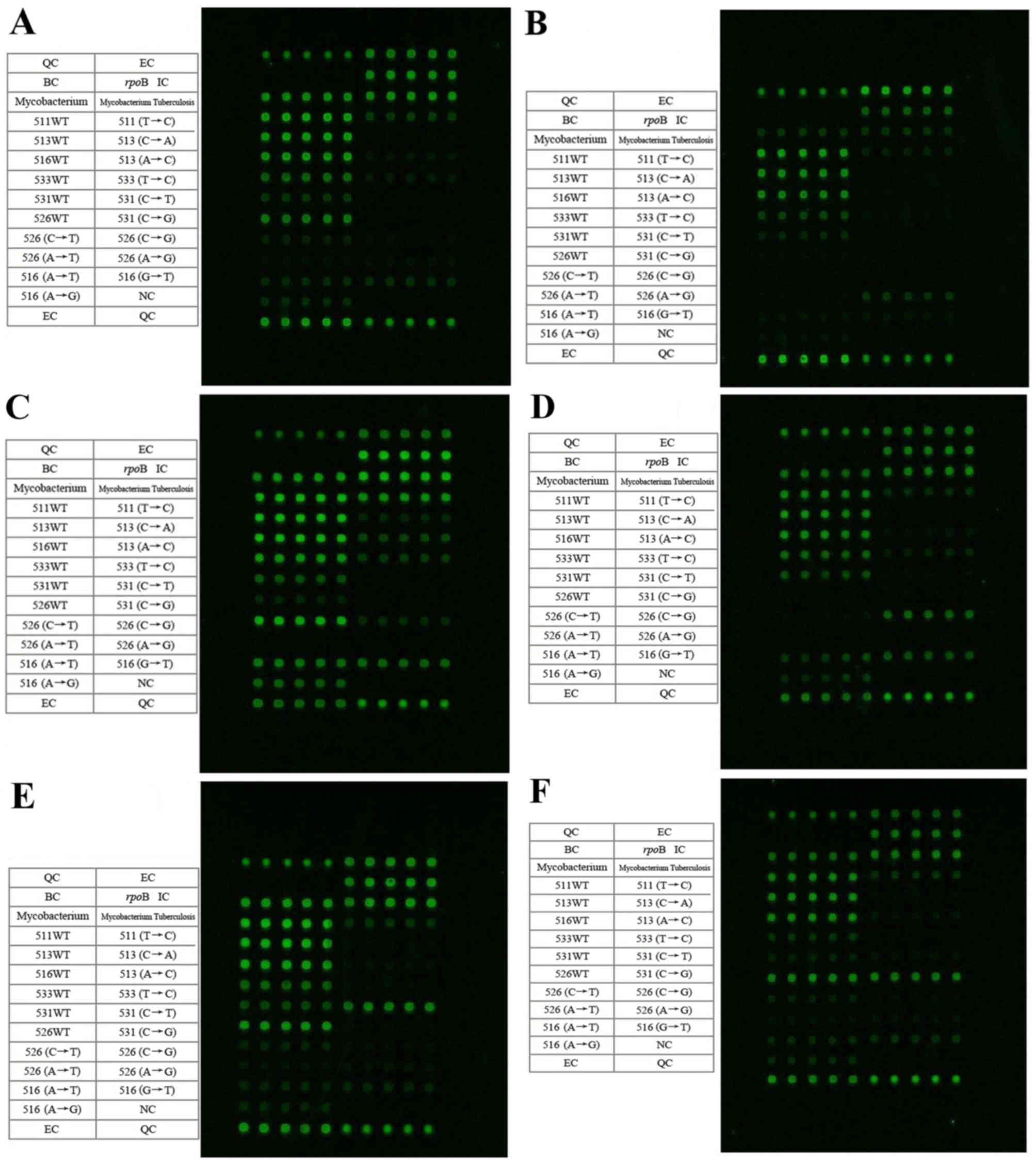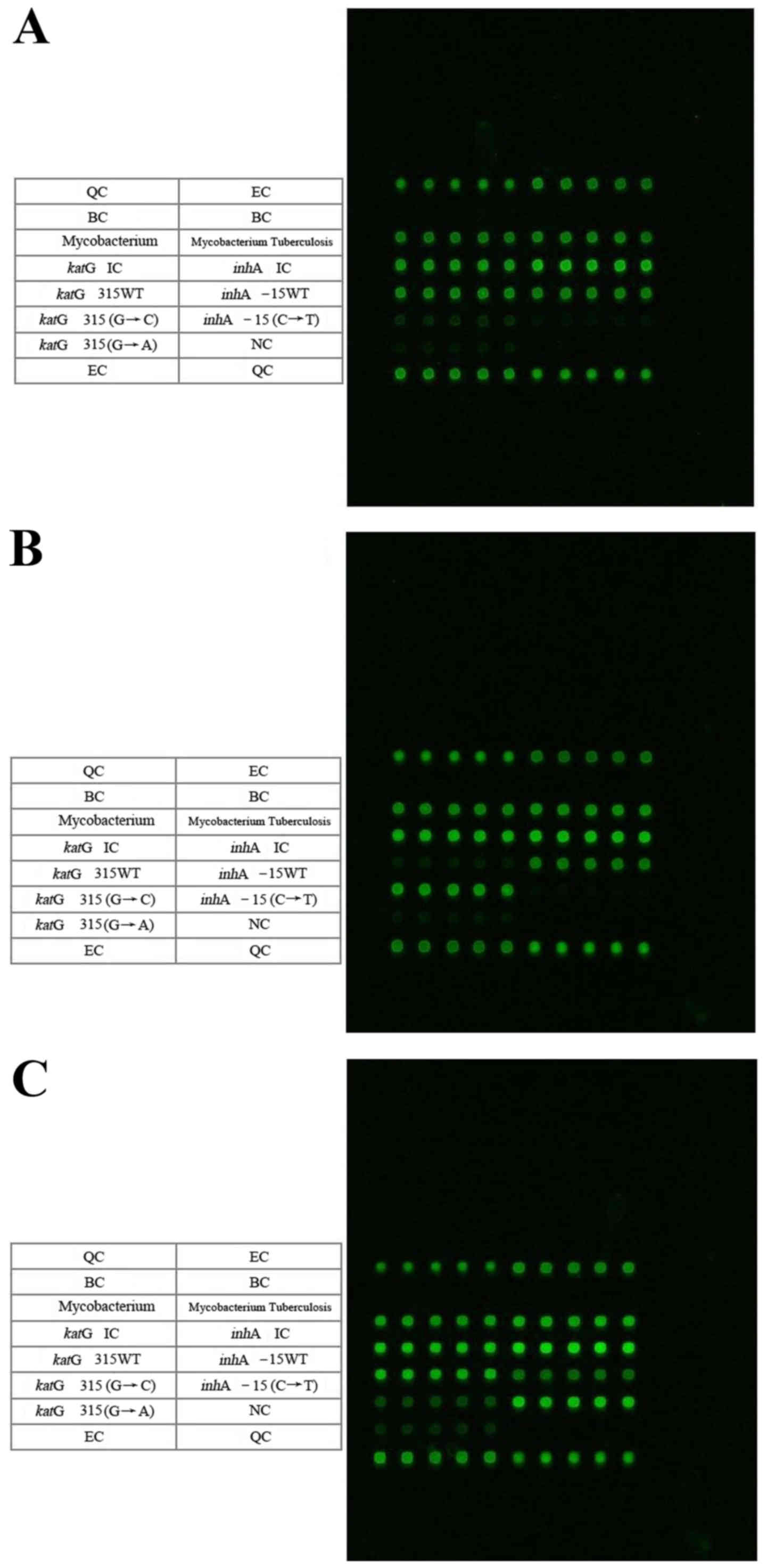|
1
|
Maimaiti R, Zhang Y, Pan K, Mijiti P,
Wubili M, Musa M and Andersson R: High prevalence and low cure rate
of tuberculosis among patients with HIV in Xinjiang, China. BMC
Infect Dis. 17:152017. View Article : Google Scholar : PubMed/NCBI
|
|
2
|
Timmins GS and Deretic V: Mechanisms of
action of isoniazid. Mol Microbiol. 62:1220–1227. 2006. View Article : Google Scholar : PubMed/NCBI
|
|
3
|
Ranguelova K, Suarez J, Magliozzo RS and
Mason RP: Spin trapping investigation of peroxide-and
isoniazid-induced radicals in Mycobacterium tuberculosis
catalase-peroxidase. Biochemistry. 47:11377–11385. 2008. View Article : Google Scholar : PubMed/NCBI
|
|
4
|
World Health Organization (WHO), .
Anti-tuberculosis drug resistance in the worldFourth global report.
WHO; Geneva: 2008
|
|
5
|
Yu X, Shen X, Tang P, et al: Analysis of
multi-drug resistance of Mycobacterium tuberculosis derived from
tuberculosis patients in Suzhou city. J Clin Pulmon Med.
17:269–270. 2012.
|
|
6
|
Li G: The study of drug sensitivity for
mycobacteria, Modern phthisiology. Beijing, PLA Medical
Publication; pp. 36–57. 2000
|
|
7
|
Carbonnelle B and Carpentier E:
Bacteriological diagnosis of tuberculosis: Current hieratic
classification of methods. Rev Med Interne. 16:518–523. 1995.(In
French). View Article : Google Scholar : PubMed/NCBI
|
|
8
|
Demers AM, Venter A, Friedrich SO,
Rojas-Ponce G, Mapamba D, Jugheli L, Sasamalo M, Almeida D,
Dorasamy A, Jentsch U, et al: Direct susceptibility testing of
Mycobacterium tuberculosis for pyrazinamide by use of the bactec
MGIT 960 system. J Clin Microbiol. 54:1276–1281. 2016. View Article : Google Scholar : PubMed/NCBI
|
|
9
|
Ramaswamy S and Musser JM: Molecular
genetic basis of antimicrobial agent resistance in Mycobacterium
tuberculosis 1998 update. Tuber Lung Dis. 79:3–29. 1998. View Article : Google Scholar : PubMed/NCBI
|
|
10
|
Scarpellini P, Braglia S, Carrera P, Cedri
M, Cichero P, Colombo A, Crucianelli R, Gori A, Ferrari M and
Lazzarin A: Detection of rifampin resistance in Mycobacterium
tuberculosis by double gradient-denaturing gradient gel
electrophoresis. Antimicrob Agents Chemother. 43:2550–2254.
1999.PubMed/NCBI
|
|
11
|
Herrera L, Jiménez S, Valverde A,
García-Aranda MA and Sáez-Nieto JA: Molecular analysis of
rifampicin-resistant Mycobacterium tuberculosis isolated in Spain
(1996–2001). Description of new mutations in the rpoB gene and
review of the literature. Int J Antimicrob Agents. 21:403–408.
2003. View Article : Google Scholar : PubMed/NCBI
|
|
12
|
Van Der Zanden AG, TeKoppele-Vije EM,
Bhanu N Vijaya, Van Soolingen D and Schouls LM: Use of DNA extracts
from Ziehl-Neelsen-stained slides for molecular detection of
rifampin resistance and spoligotyping of Mycobacterium
tuberculosis. J Clin Microbiol. 41:1101–1118. 2003. View Article : Google Scholar : PubMed/NCBI
|
|
13
|
Harding CV and Boom WH: Regulation of
antigen presentation by Mycobacterium tuberculosis A role for
Toll-like receptors. Nat Rev Microbiol. 8:296–307. 2010. View Article : Google Scholar : PubMed/NCBI
|
|
14
|
Kleinnijenhuis J, Oosting M, Joosten LA,
Netea MG and Van Crevel R: Innate immune recognition of
Mycobacterium tuberculosis. Clin Dev Immunol. 21:4053102011.
|
|
15
|
Bostanabad SZ, Nojoumi SA, Jabbarzadeh E,
Shekarabei M, Hoseinaei H, Rahimi MK, Ghalami M, Dizji S Pourazar,
Sagalchyk ER and Titov LP: High level isoniazid resistance
correlates with multiple mutation in the katG encoding catalase
proxidase of pulmonary tuberculosis strains from the frontier
localities of Iran. Tuberk Toraks. 59:27–35. 2011. View Article : Google Scholar : PubMed/NCBI
|
|
16
|
Cade CE, Dlouhy AC, Medzihradszky KF,
Salas-Castillo SP and Ghiladi RA: Isoniazid-resistanee conferring
mutations in Mvcobacterium tuberculosis katG: Catalase, peroxidase,
and INH-NADH adduct formaion activities. Protein Sci. 19:458–474.
2010.PubMed/NCBI
|
|
17
|
Seifert M, Catanzaro D, Catanzaro A and
Rodwell TC: Genetic mutations associated with isoniazid resistance
in Mycobacterium tuberculosis: A systematic review. PLoS One.
10:e01196282015. View Article : Google Scholar : PubMed/NCBI
|
|
18
|
Khosravi AD, Goodarzi H and Alavi SM:
Detection of genomic mutations in katG, inhA and rpoB genes of
Mycobacterium tuberculosis isolates using polymerase chain reaction
and multiplex allele-specific polymerase chain reaction. Braz J
Infect Dis. 16:57–62. 2012. View Article : Google Scholar : PubMed/NCBI
|
|
19
|
Lin SY, Hwang SC, Yang YC, Wang CF, Chen
YH, Chen TC and Lu PL: Early detection of Mycobacterium
tuberculosis complex in BACTEC MGIT cultures using nucleic acid
amplification. Eur J Clin Microbiol Infect Dis. 35:977–984. 2016.
View Article : Google Scholar : PubMed/NCBI
|
|
20
|
Al-Rubaye DS, Henihan G, Al-Abasly AK,
Seagar AL, Al-Attraqchi AA, Schulze H, Hashim DS, Kamil JK,
Laurenson IF and Bachmann TT: Genotypic assessment of
drug-resistant tuberculosis in Baghdad and other Iraqi provinces
using low-cost and low-density DNA microarrays. J Med Microbiol.
65:114–122. 2016. View Article : Google Scholar : PubMed/NCBI
|
|
21
|
Ali IF, Babak F, Fazlollah MS and
Nematollah JJ: Rapid detection of MDR-Mycobacterium tuberculosis
using modified PCR-SSCP from clinical Specimens. Asian Pac J Trop
Biomed. 4 Suppl 1:S165–S170. 2014. View Article : Google Scholar : PubMed/NCBI
|
|
22
|
Linger Y, Kukhtin A, Golova J, Perov A,
Lambarqui A, Bryant L, Rudy GB, Dionne K, Fisher SL, Parrish N and
Chandler DP: Simplified microarray system for simultaneously
detecting rifampin, isoniazid, ethambutol, and streptomycin
resistance markers in Mycobacterium tuberculosis. J Clin Microbiol.
52:2100–2107. 2014. View Article : Google Scholar : PubMed/NCBI
|
|
23
|
Shi XC, Liu XQ, Xie XL, Xu YC and Zhao ZX:
Gene chip array for differentiation of mycobacterial species and
detection of drug resistance. Chin Med J (Engl). 125:3292–3297.
2012.PubMed/NCBI
|
|
24
|
Ohno H, Koga H and Kohno S:
Multidrug-resistant tuberculosis. 2. Mechanisms of drug-resistance
in Mycobacterium tuberculosis-genetic mechanisms of
drug-resistance. Kekkaku. 73:657–663. 1998.(In Japanese).
PubMed/NCBI
|
|
25
|
Wang SF, Zhao B, Song YY, Zhou Y, Ou XC,
Li Q, Xia H, Pang Y, Duanmu HJ, Fu Y and Zhao YL: Risk factors for
drug-resistant tuberculosis in China: analysis of the results of
the national drug resistant tuberculosisbaselinesurvey in 2007.
Chin J Antituber. 35:221–226. 2013.
|
|
26
|
van Rie A, Warren R, Mshanga I, Jordaan
AM, van der Spuy GD, Richardson M, Simpson J, Gie RP, Enarson DA,
Beyers N, et al: Analysis for a limited number of gene codons can
predict drug resistance of Mycobacterium tuberculosis in a
high-incidence community. J Clin Microbiol. 39:636–641. 2001.
View Article : Google Scholar : PubMed/NCBI
|
|
27
|
de Rossi E, Aínsa JA and Riccardi G: Role
of mycobacterial efflux transporters in drug resistance: An
unresolved question. FEMS Microbiol Rev. 30:36–52. 2006. View Article : Google Scholar : PubMed/NCBI
|
|
28
|
Danilchanka O, Mailaender C and Niederweis
M: Identification of a novel multidrug efflux pump of Mycobacterium
tuberculosis. Antimicrob Agents Chemother. 52:2503–2511. 2008.
View Article : Google Scholar : PubMed/NCBI
|
|
29
|
Heep M, Brandstätter B, Rieger U, Lehn N,
Richter E, Rüsch-Gerdes S and Niemann S: Frequency of rpoB
mutations inside and outside the cluster I region in
rifampin-resistant clinical Mycobacterium tuberculosis strains. J
Clin Microbiol. 39:107–110. 2001. View Article : Google Scholar : PubMed/NCBI
|











